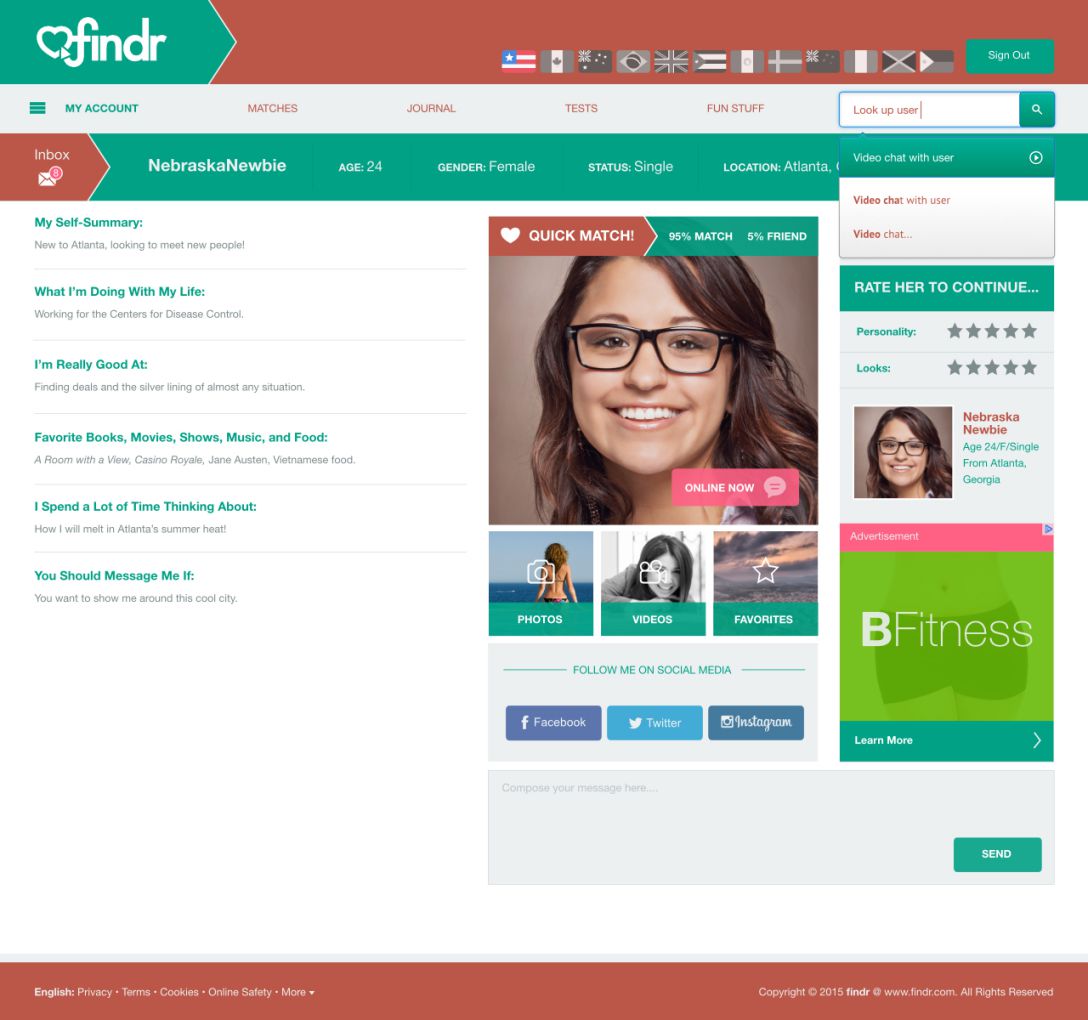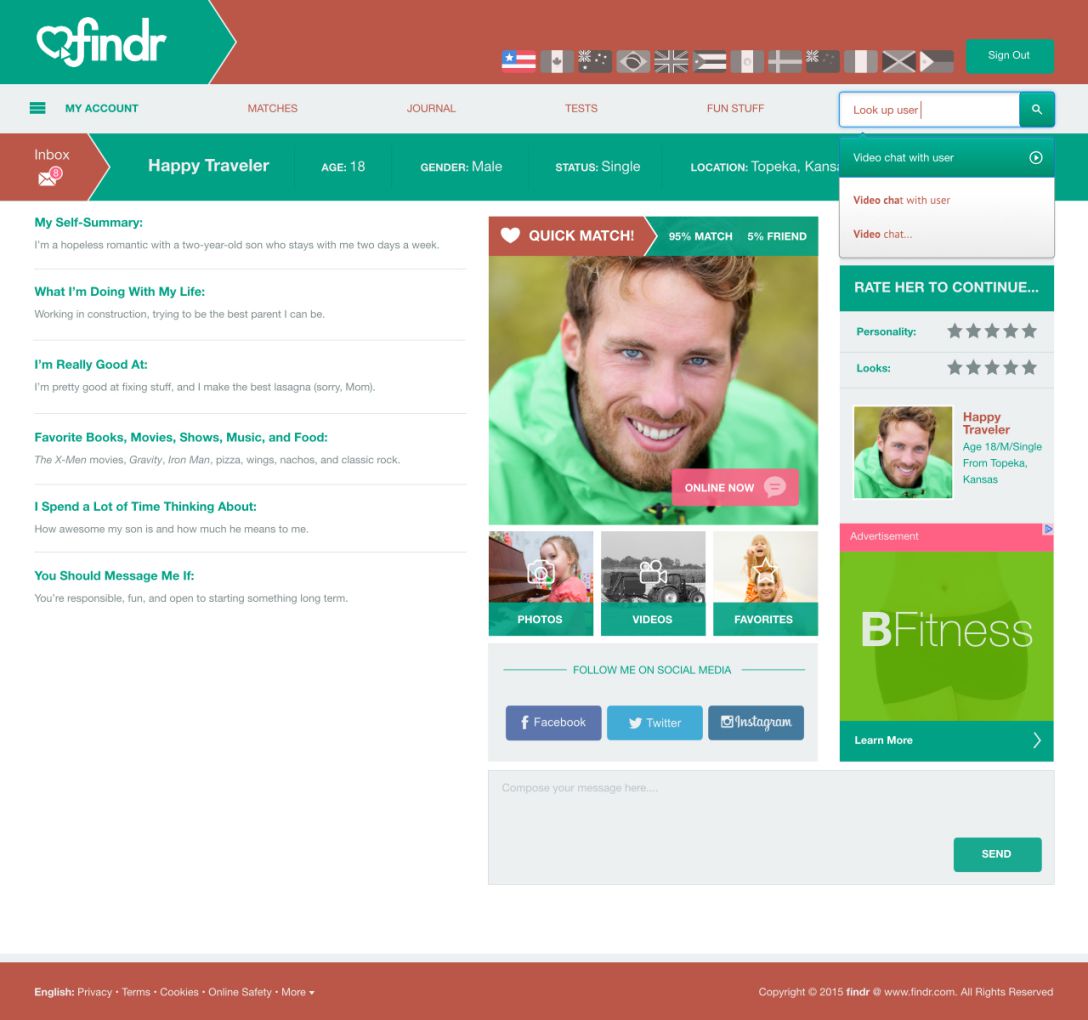Chapter 12. Online Dating
12.1 Introduction
Think Like a Scientist
Online Dating
By:
Susan A. Nolan, Seton Hall University
Sandra E. Hockenbury
REFERENCES
Lewandowski, Gary W.; Aron, Arthur; & Gee, Julie. (2007). Personality goes a long way: The malleability of opposite-sex physical attractiveness. Personal Relationships, 14, 571–585.
Lorenzo, Genevieve. L.; Biesanz, Jeremy C.; & Human, Lauren J. (2010). What is beautiful is good and more accurately understood: Physical attractiveness and accuracy in first impressions of personality. Psychological Science, 21, 1777–1782.
Rudder, Christian. (July 28, 2014). We experiment on human beings! OkTrends: Dating Research from OkCupid. Retrieved from http://blog.okcupid.com/index.php/page/2/
Sheppard, Leah D.; Goffin, Richard D.; Lewis, Rhys J.; & Olson, James. (2011). The effect of target attractiveness and rating method on the accuracy of trait ratings. Journal of Personnel Psychology, 10(1), 24–33.
Smith, Aaron., & Duggan, Maeve. (October 21, 2013). Online dating and relationships. Pew Research Center. Retrieved from http://www.pewinternet.org/2013/10/21/online-dating-relationships/
Smith, Eliot R., & Collins, Elizabeth C. (2009). Contextualizing person perception: Distributed social cognition. Psychological Review, 116, 343–364.
FAQ
What is Think Like a Scientist?
Think Like a Scientist is a digital activity designed to help you develop your scientific thinking skills. Each activity places you in a different, real-world scenario, asking you to think critically about a specific claim.
Can instructors track your progress in Think Like a Scientist?
Scores from the five-question assessments at the end of each activity can be reported to your instructor. To ensure your privacy while participating in non-assessment features, which can include pseudoscientific quizzes or games, no other student response is saved or reported.
How is Think Like a Scientist aligned with the APA Guidelines 2.0?
The American Psychological Association’s “Guidelines for the Undergraduate Psychology Major” provides a set of learning goals for students. Think Like a Scientist addresses several of these goals, although it is specifically designed to develop skills from APA Goal 2: Scientific Inquiry and Critical Thinking. “Online Dating” covers many outcomes, including:
- Interpret, design, and conduct basic psychological research: Define and explain the purpose of key research concepts that characterize psychological research [identify independent and dependent variables in a study]
- Use scientific reasoning to interpret psychological phenomena: Ask relevant questions to gather more information about behavioral claims [consider alternative explanations offered by psychology research]
12.2 Introduction
This activity invites you to explore claims about how we judge online dating profiles. First, you’ll review several online dating profiles and rate each of them. Next, you’ll examine evidence from a study that the online dating site OkCupid conducted on their members. Then you’ll consider alternative explanations for the OkCupid findings by examining psychology research on person perception. Finally, you’ll look at the source of the data—an online, for-profit company—and ask questions about the potential for bias in this type of research.
12.3 Identify the Claim
1
Identify the Claim
12.3.1 Have You Tried Online Dating?
Online dating is increasingly popular. About 40% of those who describe themselves as “single and looking” have tried online dating (Smith & Duggan, 2013). As the graph below shows, online dating has become a more and more acceptable way to meet someone.
Psychology research has told us a lot about factors that affect which people we’re attracted to in real life settings. Now that research is helping us understand which people we’re attracted to online. If you have an online dating profile, you know firsthand how you evaluate potential dates. But even if you’ve never tried online dating, you probably have a sense of what you’d look for. In the next set of screens, you’ll get a chance to rate some profiles.

12.3.2 Rating Online Dating Profiles
Now it’s time to rate some fictional online profiles. Select whether you prefer to rate men or women by clicking on one of the two images below.

Rate him to continue.

Rate her to continue.
12.3.3 Rate the First Dating Profile
Rate this man in terms of looks and personality. (You can see a larger version of the profile by clicking on it.)


12.3.4 Rate the Second Dating Profile
Rate this man in terms of looks and personality. (You can see a larger version of the profile by clicking on it.)


12.3.5 Rate the Third Dating Profile
Rate this man in terms of looks and personality. (You can see a larger version of the profile by clicking on it.)


12.3.6 Rate the Fourth Dating Profile
Rate this man in terms of looks and personality. (You can see a larger version of the profile by clicking on it.)


12.3.7 Determining Personality Rating
You just rated four people for looks and personality based on their online dating profiles. Now, in a couple of sentences, explain how you determined the personality rating for the four profiles. What was your general strategy for how you judged these people’s personalities?
Question
12.3.8 Identifying the Claim
Based on your experience rating these four dating profiles, let’s identify a claim about the use of photos—and perhaps attractiveness—in assessing the personality of people based on their online dating profiles.
Question 1.
Click on the claim that most closely matches your experience.
| A. |
| B. |
12.4 Evaluate the Evidence
2
Evaluate the Evidence
12.4.1 "We Experiment on Human Beings!"
It turns out that a major online dating company, OkCupid, tested your claim—that people rely on attractiveness when rating personality only if there isn’t other information available (Rudder, 2013). In fact, if you used OkCupid in 2013, you may have been in this experiment! Let’s look at what they did.
A blog post titled “We Experiment on Human Beings!” summarized the results of several experiments that were conducted on the site’s users. In its earlier years, OkCupid allowed for separate ratings of looks and personality, just as you saw in the profiles you rated. Data from those early profiles showed that ratings of looks and ratings of personality were strongly related. The graph shows the highly positive correlation of the two ratings for each profile. Almost without exception, the looks and personality scores were no more than a half point apart.

12.4.2 The OkCupid Study, Part I
Now OkCupid has one overall rating scale. After all, there’s no point in separating scores for looks and personality if they’re pretty much identical. So, OkCupid conducted an experiment on the new single scale to test whether people rate profiles based only on the photo, while ignoring any text. To test this idea, OkCupid hid a profile’s text half of the time so only the photo was available. The other half of the time, they showed the whole profile—text and photo.
Question 2.
What is the independent variable in this study?
| A. |
| B. |
| C. |
| D. |
Question 3.
What is the dependent variable in this study?
| A. |
| B. |
| C. |
| D. |
12.4.3 The OkCupid Study, Part II
If your OkCupid profile was used in this study, it received two scores—one for your full profile and one for your profile with just the photo (no text). Earlier, you hypothesized that people only took the photo into account when judging personality if that was the only piece of information. Turns out that’s not the case.
You can see the findings in this graph. The ratings were basically the same with or without the text. Here’s OKCupid co-founder and researcher, Christian Rudder's, take-away from the OkCupid experiment: “So, your picture is worth that fabled thousand words, but your actual words are worth . . . almost nothing” (Rudder, 2013).

12.5 Consider Alternative Explanations
3
Consider Alternative Explanations
12.5.1 Why Do We Use Looks to Judge Personality?
According to Rudder, the site’s users viewed looks and personality as “the same thing, which of course makes perfect sense because, you know, this young female account holder, with a 99th percentile personality … and whose profile, by the way, contained no text, is just so obviously a really cool person” (Rudder, 2013).
This snarky example makes fun of the fact that most of us are fine using just a photo to judge a stranger’s personality. The researcher’s sarcasm suggests that we don’t really care about personality as long as someone is attractive. But thinking like a scientist requires us to consider alternative explanations.

12.5.2 Alternative Explanation #1
Alternative explanation #1: We believe in a link between looks and personality. The researcher’s explanation for the fact that we judge personality based on looks seems to be that we don’t really care about personality. But there are other possible explanations, as we learned in the chapter on social psychology. For example, research shows that people tend to believe that more attractive people actually have better personalities than less attractive people, which is known as the “what is beautiful is good” stereotype (Lorenzo & others, 2010). In fact, movies and TV shows often use this stereotype to quickly cue an audience to a character’s role. Even if you know nothing about the Harry Potter or Hunger Games series, you can probably guess that Lord Voldemort (the top photo) is evil, and you can probably guess just from their looks that Katniss Everdeen and Peeta Mellark (the bottom photo) are good.


12.5.3 Alternative Explanation #2
Alternative explanation #2: There really is a link between looks and personality. The stereotype that “what is beautiful is good” might be true. Research shows that attractive people actually tend to have more positive personality traits than average-looking people (Sheppard & others, 2011). Researchers believe this occurs because attractive people tend to receive more favorable treatment from others—parents, teachers, employers, and peers—based on their looks. It’s possible we have picked up on this pattern without being fully aware of it.
So, OkCupid’s research tells us that profiles are rated primarily based on the photo. And we have three competing explanations for that finding.
Question 4.
Based on the psychology research, which explanation is the LEAST likely to be backed by evidence?
| A. |
| B. |
| C. |
12.5.4 Not Hot? Don’t Worry!
A good scientist always remembers that any psychology finding is about groups, not any one specific person. So, on average, more attractive people might have more positive personality traits than less attractive people. But there are always individual differences—people who don’t fit the group pattern. We can all think of plenty of people who aren’t widely considered attractive, but who are funny or cool – such as Lena Dunham or Zach Galifianakis (pictured below). And there are plenty of highly attractive people who are difficult to be around. For example, good-looking actors and actresses like Russell Crowe, Julia Roberts, Jennifer Lopez (pictured below), and Christian Bale are notoriously difficult to work with on set.


12.5.5 First Impressions Don’t Always Last
The good news for those of us who fall short of Hollywood standards of beauty: First impressions don’t always last. If we can get to the stage of meeting someone in person, we adjust our perceptions as we get to know that person better (Smith & Collins, 2009). And even in dating profiles, we can adjust perceptions—without having to meet someone in person. When researchers showed a photo paired with desirable personality traits, perceptions of physical attractiveness (on a scale from 1-10) increased for both women and men, as you can see in the graph (Lewandowski & others, 2007). The opposite occurred when researchers showed undesirable personality traits alongside a photo. Both women and men then found the person in the photo to be less attractive, as you can see in the graph.

12.6 Consider the Source of the Research or Claim
4
Consider the Source of the Research or Claim
12.6.1 OkCupid’s goal
When a for-profit company conducts research, always consider how this might influence their findings. Which of the following are likely reasons that OkCupid conducts experiments on their users?
Question 5.
OkCupid wants to attract media attention that might turn into more users, which leads to more money from advertisers.
| A. |
| B. |
Question 6.
OkCupid wants to understand the online dating process better so that it works better for their users.
| A. |
| B. |
Question 7.
OkCupid wants to develop a data set they could share with psychology researchers trying to better understand the perception of attractiveness in people.
| A. |
| B. |
12.6.2 When Money Is Involved, Ask More Questions
When money and research are involved together, think like a scientist and ask more questions. First, ask questions about ethics. Research conducted by people at for-profit companies is not always subject to important ethical safeguards. For example, ask whether participants have given informed consent, as well as how their data are stored and shared. For example, OkCupid users did not realize they participated in experiments.
Second, ask questions about peer review. OkCupid data didn’t use the gold standard of peer review; other scientists did not give their stamp of approval to this research. So, we need to ask whether these data fit with or conflict with existing science. In this case, the OkCupid data seem to fit with research on the “what is beautiful is good” stereotype. But they do not seem to fit with other research in which a photo plus a description of positive personality traits led to higher ratings of attractiveness than just a photo (Lewandowski & others, 2007). So, the full story of how we judge personality may be more subtle, and we probably don’t judge people’s personalities based just on their looks.

12.7 Assessment
Assessment
12.7.1 Assessment
Question
Which of the following social psychology research areas is most relevant when we are rating someone’s online dating profile?
| A. |
| B. |
| C. |
| D. |